Missouri has many scenic and challenging trails for riders. Many areas with streams, rivers, hills and trees have numerous trails on which local groups can ride. Abandoned roads or logging trails are ideal for trail riding. Some riders enjoy riding in groups and join local saddle clubs or trail riding clubs. Riders can take advantage of trails available on public and private lands.
Riding on public lands
Many public land management agencies like the Missouri Department of Conservation give access to trails and roads on public lands. Trail riders should avoid venturing off designated trails or riding on trails where horses are not permitted. Sometimes part of a state park is set aside for trail riding. Cooperative planning between riders and city governments can help make sure that good horse trails and extensive facilities for camping are included in large parks. Missouri State Parks have many trails available for riding. Information about trails allowing horses in Missouri state parks can be found at: https://mostateparks.com/activity/horseback-riding.
Missouri Department of Conservation also has many trails for riding. A map and information about these trails can be found on the Conservation Areas Search.
The National Park Service also has resources for finding trails in the Ozark National Scenic Riverways to ride on its Horseback Riding page.
The United States Department of Agriculture Forest Service has an extensive list of available trails via its Horse Riding Areas page.
Some riders may choose to ride on the side of public roads. Check local highway departments in case there is an ordinance against use by riders. Although road riding may not be the most desirable, it is a good place to ride when getting a horse in condition or when going from one scenic area to another.
Ride on private lands
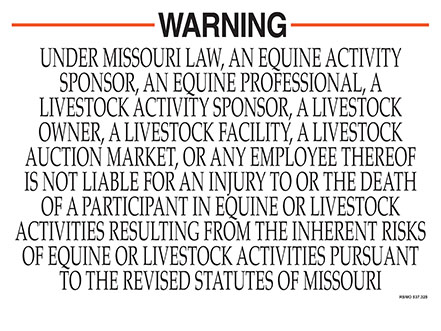
Private land may be used with permission from the owners. Some landowners may require a liability waiver to be signed to protect themselves from liability if someone was hurt while on their property. Landowners that allow people to trail ride on their property may want to purchase a livestock liability sign.
Some privately owned facilities have created a business of offering single or multi-day trail riding opportunities for horse owners. These businesses often offer maintained trails as well as stalls or pens for horses. Some facilities will also have cabins and trailer or camper hookups for the guests to stay in. Some facilities may even have dining halls, general stores, and tack shops that offer food, tack, and other goods for the guests. Many trail riding facilities offer both day rates for riding as well as camping or hookup rates to cater to riders who want to ride then haul home as well as riders who want to camp and stay several days. Many facilities will organize large rides a few times a year.
Organizing a ride
Many riders prefer to ride in a group. Saddle clubs are turning out in larger numbers for trail riding. Some organized rides are set up to benefit a specific charity, while others are planned with the sole purpose of providing enjoyment and community among riders. Although an impromptu trail ride can be organized at any time, usually it is easier to have appointed committees for the ride.
A trail boss and drag rider committee will lay out the trail on a map, or from memory, and will call the landowners for permission to use it. The committee then rides the trail, cuts down brush if necessary, and hangs ribbons to mark the trail so riders will not get lost. They also time the length of the ride and plan areas for rest and refreshment stops.
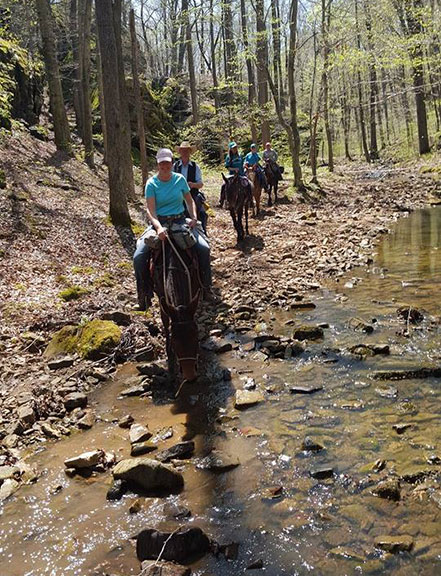
A publicity committee is needed if many riders are invited. They prepare flyers or other advertising media with the time, location, distance and equipment that riders need to bring. They may print flyers and post them in saddle shops, feed stores and other locations that attract horse people. Many trail ride organizers and groups will have social media pages to get information about impromptu or planned rides to other riders. When using publicity, it is important to be prepared to handle many riders. Often, more people attend the trail ride than are expected.
A concession committee may decide to have refreshments available or will communicate the need for riders to pack their own lunch for the ride. Trash cans for litter should be provided at every stop.
Most larger rides should have a cleanup committee. Riders with saddlebags are designated to collect trash to be sure nothing is left on the trail. They also assume responsibility for cleaning the camp site before trail riders leave.
Campgrounds should have a large parking area and water for people and animals. If the weather is hot, shade and water are necessities. The trail boss and assistants should select the site for riders to park and camp.
Sleeping accommodations on rides range from pup tents to elaborate travel trailers. If the ride is close to home, riders may wish to leave their horses and sleep at home.
Someone in the group should be designated to keep track of the weather conditions. Storms can bring lightning, flooding of creeks and rivers, and even slippery footing that could be hazardous to both horse and rider.
What to expect during a group ride
Courtesy in trail riding is important. Arrive at the location in time to prepare the horses and leave on schedule. Don’t delay the ride.
After orienting the group, the trail bosses lead out. Riders should not pass them and should remember they are guests of landowners. One horse length should be kept between riders with drag riders bringing up the rear.
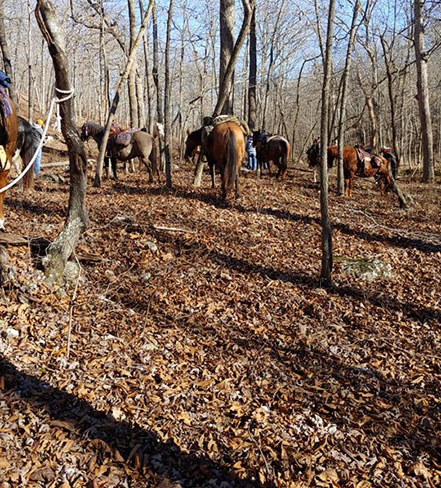
It is a good idea to start a trail ride away from public roads or other distractions if riders plan to bring young, anxious horses. After an hour on the trail, these horses tend to settle down and will tolerate strange objects.
The trail boss will periodically stop the ride to check for overheated horses. The trail boss rides back from the front of the trail while drag riders from the back ride forward. This gives the horses time to rest and allows riders to check their saddle cinches.
Rides should not cover too much distance or be taken at excessive speed. Riders and horses usually enjoy about a three-hour ride in the morning and a two- to three-hour ride in the afternoon. Also, the steepest obstacles should be on the morning ride. Most horses and riders will be more tired in the afternoon, and some horses may lose shoes or develop lameness as the day progresses.
The ride should be kept at a reasonable pace, with a refreshment stop in the morning and the afternoon. Riders may wish to carry water and a snack with them.
An hour is usually taken for lunch. Most riders loosen the cinch on their saddles while the horse rests during lunch. Be sure a tie rope or halter is available for the horse. Horses are not fed at lunch, but they should be watered. Hot horses, however, should not be allowed to drink large amounts of cold water until they cool out to avoid causing the horse to colic.
What to bring for people and horses
If the heat or humidity is excessive, riding may only occur in the morning. As the heat of the day increases, the trail should lead to shaded areas. When riding through timber, long sleeves may be needed. Raincoats and warm layers should always be carried in case of weather changes on the trail. Branches are also a "headache" for riders wearing wide-brimmed hats. If the ride is in brushy country, wear a narrow-brimmed hat, a cap, or go without a hat. In hot weather or in areas of intense sunshine, hats usually are desirable. Riders should also bring insect repellent, sunscreen, and a first aid kit. For horses, at minimum, riders should bring fly spray, hoof pick, fencing pliers and hoof boots if a horse loses a shoe. Below is a suggested checklist for horse, rider, and campsite that may be useful.
Packing list
Supplies for the horse
- Halter
- Lead rope
- Neck rope
- Support boots
- Hoof boots
- Saddle
- Bridle and reins
- Saddle pads or blankets
- Breast collar or crupper
- Saddle bags/Pommel bags
- Cinch
- Picket line or portable fencing
- Hay
- Grain
- Feed supplements
- Water (if not available on site)
- Manure rake
- Feed and water buckets
- Hay bag or net
- Feed scoop
- Fly repellant sprays
- Negative Coggins Test
- Health certificate
- First aid supplies
- Vet wrap
- Scissors
- Gauze
- Antiseptic like alcohol, peroxide, or iodine
- Wound ointment or spray
- Tape
- Needles
- Syringes
- Anti-inflammatory/pain reliever like flunixin meglumine or phenylbutazone
- Thermometer
- Disposable gloves
Supplies for the rider
- Head lamp
- Riding attire
- Rain gear
- Jacket or coat
- Pocket Knife
- Hat
- Helmet
- Sunscreen
- Insect repellent
Supplies for the trail
- Hoof pick
- Pocket knife
- Fencing pliers
- Lunch or snacks
- Water bottle
- Halter and lead rope
- Helmet
- Saddle bags/pommel bags
- Insect repellent
- Sunscreen
- Rain gear
- Map of the trail
- Bag for trash
- Hobbles
Supplies for the camp
- Tent and stakes
- Sleeping bag, blankets, and pillow
- Cot or air mattress
- Hammer
- Waterproof tarp
- Lantern
- Chairs
- Table
- Garbage bags
- Water
- Flashlights or head lamps
- Food
- Cooking supplies
- Utensils
For a printable version of this checklist, please see MU Extension publication G2885, Trail Riding Checklist.
When is it too hot to ride?
Riders should evaluate temperature and humidity to determine if riding is a good idea on certain days. Riders should also spend more time resting their horses, reduce riding, and watch for heat stress or heat stroke if choosing to ride when the heat and humidity is high. Table 1 explains the ability of a horse to cool itself at various temperatures.
For example, on a day that is 78°F with 85% humidity, the horse would have a great reduction in the ability for it to cool itself by breathing and sweating. This type of weather could cause a horse and rider to become heat stressed or cause heat stroke if caution is not taken.
Table 1. Riders should add together the air temperature and the percentage humidity to evaluate if their horse can effectively cool itself.
| Air Temperature (°F) + Humidity (%) | Ability for horse to cool itself |
|---|---|
|
Less than 130 |
Most effective at cooling |
|
130-150 |
Decreased ability to cool itself |
|
151-180 |
Great reduction in ability to cool itself |
|
Greater than 180 |
Great reduction in ability to cool itself. Potential to be fatal if horse is under stress. |
Hoof care considerations
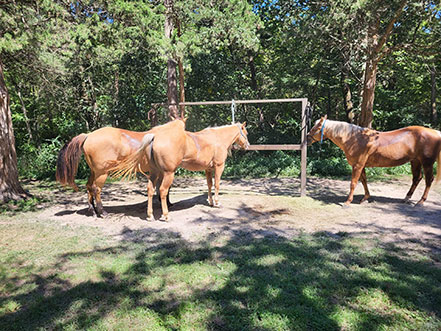
Some rides involve road riding on gravel roads. Additionally, many trails in the southern part of Missouri are very rocky. For these reasons, horses need to be shod in advance. Riders should plan ahead and make sure their horses are not long in the toe or have loose shoes before the start of the ride. Most horses cannot travel barefoot two or three miles on a gravel road without developing sore feet. Pads underneath the shoes or hoof boots can also provide more comfort and prevent soreness for horses. At trail breaks, it is a good idea to check your horse’s hooves and pick out any rocks or other foreign objects that could cause lameness issues.
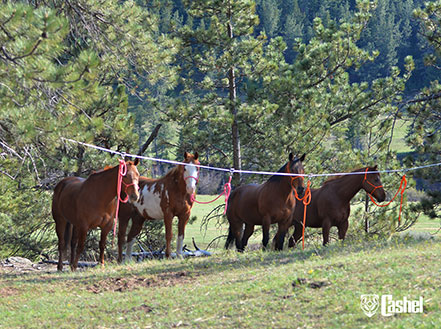

Securing horses for the evening
It is important to secure horses safely at the end of the day to avoid horses getting loose or injured. When on a multi-day ride, stalls or corrals may be available to house horses. Many riding trails and campgrounds have hitching posts or tying areas for horses.

If camping away from corrals or stalls, a picket line or high line can be used to secure horses overnight.
Using rope that is approximately ½” in diameter is lightweight to carry on the ride but strong. Use a rope with a 10,000-pound breaking strength so the horse will not get loose. The rope should be at least 15 feet long if tying two horses and five feet of length should be added for each additional horse. Tree saver straps prevent damage to the trees selected for the picket line. Swiveling picket line ties can also be used. These items can be easily purchased in a kit.
If your horse is broke to do so, another alternative is to use hobbles. Hobbles can be brought on the trail and used during breaks to allow the horse to rest and graze.
Regardless of how you secure your horse for the evening, it will still need to be fed and watered. A common way to provide hay is using a hay bag or hay net. Tie the hay nets high enough to prevent the horse from getting its feet in it. If the horse is not tied properly, it can step over the halter shank or become tangled in the meshes of the hay net. Horses can be permanently injured if circulation is cut off while entangled in hay nets. Horses should not be left alone with water or feed buckets on the ground to avoid potential leg injuries.

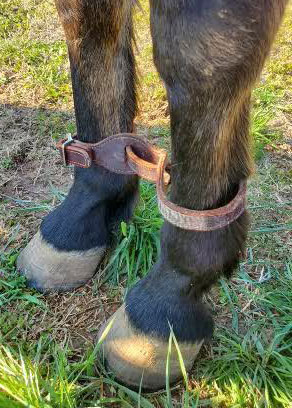
Crossing water on the trail
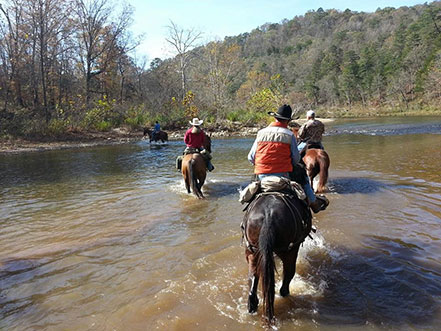
River and stream sites are good places to camp because there will be water for the animals but be cautious when crossing a stream on horseback. Stream crossings should have solid bottoms and banks that can be negotiated without danger of the horse falling. In a swift stream, when water reaches halfway up a horse’s side, its feet may be swept from under it. Children should cross streams only with supervision, particularly if they are on small ponies. If a horse is refusing to cross the stream, a more seasoned horse can be used to give the other confidence by riding in front of or beside the greener horse. When crossing streams, riders should pay attention as horses may try to paw and roll in the water.
Summary
In summary, trail riding can be an excellent activity to enjoy horses and socializing with friends. The key to organizing or having an enjoyable ride is to plan ahead and consider the safety of the riders and horses. Preparation for various weather conditions and rider levels is critical.
Resources
To find a complete list of publications, videos, and other resources, visit the Equine Extension program.
- G2835 – Buying a Horse
- G2844 – Haltering and Tying
- G2864 – Pre-Bit Hackamore Training
- G2870 – Tips for Pony Pleasure Drivers
- G2878 – Safe Ground Handling of Horses
- G2881 – Saddling, Bridling and Riding the Western Horse
- G2882 – Safety for Hunt Seat Riders
- G2883 – Intermediate Trail Riding
- G2885 – Trail Riding Checklist
- G2887 – Selecting a Saddle